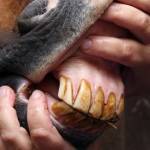Feeding Practices May Impact Horse Dental Health

Wild or feral horses in a natural setting spend a lot of time—up to 18 hours a day—eating a variety of forage plants and very few, if any, sources of concentrated energy. Though they raise their heads frequently to look around for danger, they graze and chew in a head-down position.
Domesticated horses, especially those that spend a lot of time in stalls, live a considerably different life. They graze a narrower range of forage types, eat hay containing even fewer grass or legume strains, and can usually avoid tougher plants that require extensive chewing. They are often given large, energy-dense grain meals that take very little time to consume, and they eat hay and grain from feeders and nets that are placed well above ground level. Different foods that are eaten more quickly with the horse’s head in a different position may be factors that contribute to some dental problems in modern horses.
The front teeth in a horse’s mouth are incisors. These blade-like teeth are used to grasp and tear forage and pick up mouthfuls of grain. Behind the incisors on each side is a stretch of gum without teeth, and further back in the mouth are the flatter premolars and molars that are used to crush feed by a side-to-side grinding motion. The lower jaw is narrower than the upper jaw, so a significant lateral motion is needed to allow the upper molars to wear down evenly. Teeth that don’t get wear all the way to the outer edges can develop sharp enamel points.
Some forage encountered by wild horses tends to be coarser, requiring a longer period of side-to-side grinding with the molars. Wild equines such as zebras and Przewalski’s horses tend to have lateral points on their molars that are much less pronounced than those found on the teeth of domestic horses. The sharper points developed by many domestic horses may be related to a diet that can be chewed more quickly and easily with less range of jaw motion.
Easier chewing may mean that the teeth don’t wear as fast or as evenly, requiring dental intervention for domestic horses to keep the lateral points rasped down. Eating hay and grain from elevated feeders and nets rather than from the ground may also align the horse’s jaws differently, allowing the teeth to meet in a slightly unnatural position. Over time, this might lead to uneven wear compared to wild horses that always eat in a head-down position.
Most domestic horses can’t practically be managed on total turnout in areas of rough, stemmy forage, even though this management style might lead to fewer dental problems. Therefore, all horses should have their teeth checked and necessary dental corrections applied at least once or twice a year. Owners can also take steps such as feeding hay from the ground and offering grain in tubs on the ground rather than in raised feeders.








